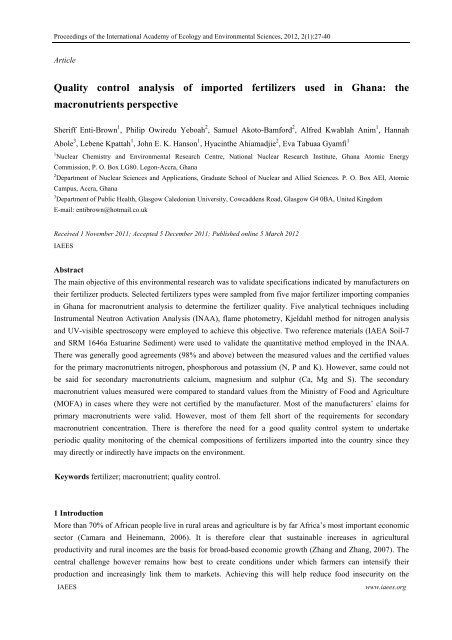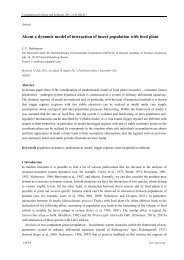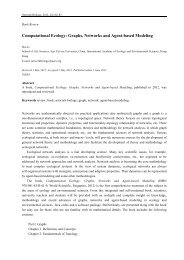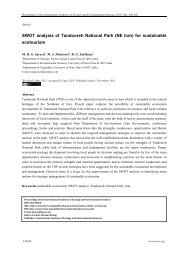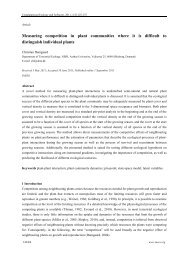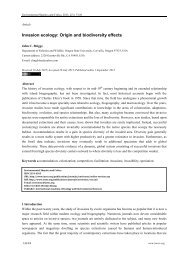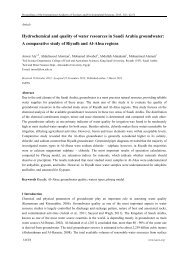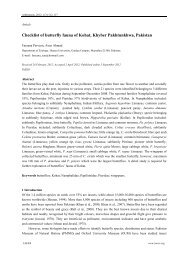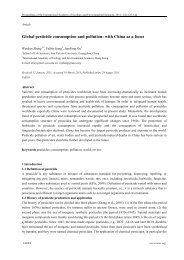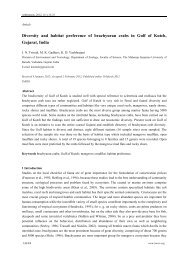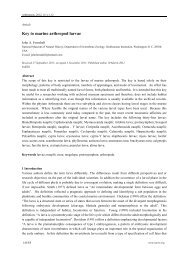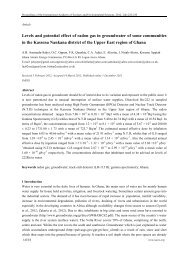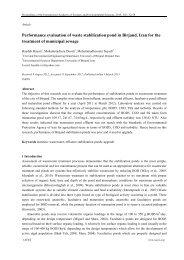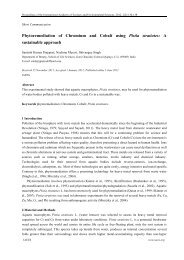Quality control analysis of imported fertilizers used in Ghana: the ...
Quality control analysis of imported fertilizers used in Ghana: the ...
Quality control analysis of imported fertilizers used in Ghana: the ...
You also want an ePaper? Increase the reach of your titles
YUMPU automatically turns print PDFs into web optimized ePapers that Google loves.
Proceed<strong>in</strong>gs <strong>of</strong> <strong>the</strong> International Academy <strong>of</strong> Ecology and Environmental Sciences, 2012, 2(1):27-40<br />
Article<br />
<strong>Quality</strong> <strong>control</strong> <strong>analysis</strong> <strong>of</strong> <strong>imported</strong> <strong>fertilizers</strong> <strong>used</strong> <strong>in</strong> <strong>Ghana</strong>: <strong>the</strong><br />
macronutrients perspective<br />
Sheriff Enti-Brown 1 , Philip Owiredu Yeboah 2 , Samuel Akoto-Bamford 2 , Alfred Kwablah Anim 1 , Hannah<br />
Abole 3 , Lebene Kpattah 1 , John E. K. Hanson 1 , Hyac<strong>in</strong><strong>the</strong> Ahiamadjie 2 , Eva Tabuaa Gyamfi 1<br />
1 Nuclear Chemistry and Environmental Research Centre, National Nuclear Research Institute, <strong>Ghana</strong> Atomic Energy<br />
Commission, P. O. Box LG80. Legon-Accra, <strong>Ghana</strong><br />
2 Department <strong>of</strong> Nuclear Sciences and Applications, Graduate School <strong>of</strong> Nuclear and Allied Sciences. P. O. Box AEI, Atomic<br />
Campus, Accra, <strong>Ghana</strong><br />
3 Department <strong>of</strong> Public Health, Glasgow Caledonian University, Cowcaddens Road, Glasgow G4 0BA, United K<strong>in</strong>gdom<br />
E-mail: entibrown@hotmail.co.uk<br />
Received 1 November 2011; Accepted 5 December 2011; Published onl<strong>in</strong>e 5 March 2012<br />
IAEES<br />
Abstract<br />
The ma<strong>in</strong> objective <strong>of</strong> this environmental research was to validate specifications <strong>in</strong>dicated by manufacturers on<br />
<strong>the</strong>ir fertilizer products. Selected <strong>fertilizers</strong> types were sampled from five major fertilizer import<strong>in</strong>g companies<br />
<strong>in</strong> <strong>Ghana</strong> for macronutrient <strong>analysis</strong> to determ<strong>in</strong>e <strong>the</strong> fertilizer quality. Five analytical techniques <strong>in</strong>clud<strong>in</strong>g<br />
Instrumental Neutron Activation Analysis (INAA), flame photometry, Kjeldahl method for nitrogen <strong>analysis</strong><br />
and UV-visible spectroscopy were employed to achieve this objective. Two reference materials (IAEA Soil-7<br />
and SRM 1646a Estuar<strong>in</strong>e Sediment) were <strong>used</strong> to validate <strong>the</strong> quantitative method employed <strong>in</strong> <strong>the</strong> INAA.<br />
There was generally good agreements (98% and above) between <strong>the</strong> measured values and <strong>the</strong> certified values<br />
for <strong>the</strong> primary macronutrients nitrogen, phosphorous and potassium (N, P and K). However, same could not<br />
be said for secondary macronutrients calcium, magnesium and sulphur (Ca, Mg and S). The secondary<br />
macronutrient values measured were compared to standard values from <strong>the</strong> M<strong>in</strong>istry <strong>of</strong> Food and Agriculture<br />
(MOFA) <strong>in</strong> cases where <strong>the</strong>y were not certified by <strong>the</strong> manufacturer. Most <strong>of</strong> <strong>the</strong> manufacturers’ claims for<br />
primary macronutrients were valid. However, most <strong>of</strong> <strong>the</strong>m fell short <strong>of</strong> <strong>the</strong> requirements for secondary<br />
macronutrient concentration. There is <strong>the</strong>refore <strong>the</strong> need for a good quality <strong>control</strong> system to undertake<br />
periodic quality monitor<strong>in</strong>g <strong>of</strong> <strong>the</strong> chemical compositions <strong>of</strong> <strong>fertilizers</strong> <strong>imported</strong> <strong>in</strong>to <strong>the</strong> country s<strong>in</strong>ce <strong>the</strong>y<br />
may directly or <strong>in</strong>directly have impacts on <strong>the</strong> environment.<br />
Keywords fertilizer; macronutrient; quality <strong>control</strong>.<br />
1 Introduction<br />
More than 70% <strong>of</strong> African people live <strong>in</strong> rural areas and agriculture is by far Africa’s most important economic<br />
sector (Camara and He<strong>in</strong>emann, 2006). It is <strong>the</strong>refore clear that susta<strong>in</strong>able <strong>in</strong>creases <strong>in</strong> agricultural<br />
productivity and rural <strong>in</strong>comes are <strong>the</strong> basis for broad-based economic growth (Zhang and Zhang, 2007). The<br />
central challenge however rema<strong>in</strong>s how best to create conditions under which farmers can <strong>in</strong>tensify <strong>the</strong>ir<br />
production and <strong>in</strong>creas<strong>in</strong>gly l<strong>in</strong>k <strong>the</strong>m to markets. Achiev<strong>in</strong>g this will help reduce food <strong>in</strong>security on <strong>the</strong><br />
IAEES<br />
www.iaees.org
28<br />
Proceed<strong>in</strong>gs <strong>of</strong> <strong>the</strong> International Academy <strong>of</strong> Ecology and Environmental Sciences, 2012, 2(1):27-40<br />
cont<strong>in</strong>ent (Ackah et al., 2011; Sayyed and Wagh, 2011; Tiwari, 2011). However, history shows that no region<br />
<strong>in</strong> <strong>the</strong> world achieved food security and substantial productivity <strong>in</strong>creases without significantly expand<strong>in</strong>g<br />
fertilizer use (FAO, 2006; Zhang and Zhang, 2007). Africa’s soils are much depleted and poor compared to<br />
o<strong>the</strong>r cont<strong>in</strong>ents and to produce on <strong>the</strong>se soils, fertilizer is one <strong>of</strong> <strong>the</strong> major <strong>in</strong>puts that would be needed to<br />
replenish <strong>the</strong> soil (FAO, 2006).<br />
Replenish<strong>in</strong>g soil fertility is important because soil nutrient is <strong>the</strong> number-one natural resource <strong>in</strong> Africa<br />
currently be<strong>in</strong>g depleted and <strong>the</strong> nutrient capital <strong>of</strong> African soils is be<strong>in</strong>g m<strong>in</strong>ed just like m<strong>in</strong>eral deposits <strong>of</strong><br />
metals or fossil fuels (FAO, 2006). Smal<strong>in</strong>g (1993) estimates <strong>the</strong> depletion rates <strong>of</strong> soil nutrients as 22<br />
Kg/ha/yr for nitrogen (N), 2.5 Kg/ha/yr for phosphorus (P) and 15 Kg/ha/yr for potassium (K) <strong>in</strong> Africa. The<br />
challenges fac<strong>in</strong>g agriculture <strong>in</strong> <strong>Ghana</strong> are immense, with <strong>the</strong> large <strong>in</strong>crease <strong>in</strong> population over <strong>the</strong> past several<br />
few decades, <strong>the</strong>re has been <strong>in</strong>creased pressure on land, and farmers can no longer fallow <strong>the</strong>ir fields to rega<strong>in</strong><br />
fertility like <strong>the</strong>y <strong>used</strong> to. From 1988 to 1990, fertilizer use <strong>in</strong> <strong>Ghana</strong> averaged about 11,000 nutrients tons.<br />
However <strong>the</strong> nutrient requirements for <strong>the</strong> various crops for <strong>the</strong> same period were estimated to be 90,000<br />
nutrient tons (Mwangi, 1996).<br />
The implications for <strong>Ghana</strong> are clear: depletion <strong>of</strong> soil nutrients is becom<strong>in</strong>g a serious constra<strong>in</strong>t to soil<br />
fertility and crop productivity. Moreover, <strong>the</strong> level <strong>of</strong> depletion suggests that efficient and susta<strong>in</strong>able use <strong>of</strong><br />
<strong>fertilizers</strong> would be required to ma<strong>in</strong>ta<strong>in</strong> soil fertility (Mwangi, 1996). The Government <strong>of</strong> <strong>Ghana</strong> recognizes<br />
<strong>the</strong> critical role effective application <strong>of</strong> <strong>fertilizers</strong> is <strong>in</strong> <strong>in</strong>creas<strong>in</strong>g agricultural productivity and contribut<strong>in</strong>g to<br />
<strong>the</strong> achievement <strong>of</strong> national food security. Farmers throughout <strong>the</strong> country must <strong>the</strong>refore have access to good<br />
quality <strong>fertilizers</strong> at reasonable costs. The <strong>fertilizers</strong> should be appropriate for <strong>the</strong> local conditions, effective <strong>in</strong><br />
use and accord<strong>in</strong>g to <strong>the</strong> quality standards as per <strong>the</strong> label on <strong>the</strong> packag<strong>in</strong>g. <strong>Ghana</strong> imports all <strong>of</strong> its <strong>fertilizers</strong><br />
and <strong>in</strong> 2003, <strong>imported</strong> about 1.43×10 5 metric tons <strong>of</strong> fertilizer (FAO, 2005). These are mostly m<strong>in</strong>eral or<br />
<strong>in</strong>organic <strong>fertilizers</strong> that conta<strong>in</strong> <strong>the</strong> macro nutrients required by plants.<br />
Personal communications revealed that some <strong>Ghana</strong>ian farmers have raised concerns about <strong>the</strong> quality <strong>of</strong><br />
some <strong>of</strong> <strong>the</strong>se <strong>imported</strong> <strong>fertilizers</strong> <strong>the</strong>y use on <strong>the</strong>ir farms. Thus, h<strong>in</strong>t<strong>in</strong>g on <strong>the</strong> fact that some <strong>of</strong> <strong>the</strong> <strong>imported</strong><br />
<strong>fertilizers</strong> <strong>used</strong> <strong>in</strong> <strong>Ghana</strong> are not meet<strong>in</strong>g quality standards. At <strong>the</strong> moment, <strong>the</strong>re is no quality <strong>control</strong> system<br />
<strong>in</strong> <strong>the</strong> country dedicated to check<strong>in</strong>g <strong>the</strong> quality <strong>of</strong> <strong>fertilizers</strong> that come <strong>in</strong>to <strong>the</strong> country. Even though some<br />
work have already been done on <strong>fertilizers</strong> <strong>in</strong> <strong>Ghana</strong> (Addo et al., 2006; Appiah et al., 2000; Ofori-Frimpong et<br />
al., 1997), <strong>the</strong> problem <strong>of</strong> establish<strong>in</strong>g <strong>the</strong> quality criteria for <strong>imported</strong> <strong>fertilizers</strong> has not been dealt with and<br />
<strong>Ghana</strong> is yet to have a quality data base for <strong>fertilizers</strong> aga<strong>in</strong>st which any proper quality <strong>control</strong> work could be<br />
done. There is <strong>the</strong>refore <strong>the</strong> need for a system to regulate <strong>the</strong> quality <strong>of</strong> <strong>fertilizers</strong> that come <strong>in</strong>to <strong>the</strong> country to<br />
ensure that <strong>the</strong> <strong>fertilizers</strong> and crop protection chemicals <strong>of</strong>fered to <strong>the</strong> farmers are fit for <strong>the</strong> purpose stated,<br />
complies with required specifications and that adequate guidance is given to <strong>the</strong> farmer on <strong>the</strong>ir safe and<br />
effective application.<br />
The fertility status <strong>of</strong> soils <strong>in</strong> <strong>the</strong> different regions <strong>of</strong> <strong>Ghana</strong> varies considerably due to <strong>the</strong> nature <strong>of</strong> soils<br />
that are found <strong>the</strong>re (MOFA, 2003). The levels <strong>of</strong> organic carbon, nitrogen and available phosphorus are<br />
generally very low. Table 1 shows <strong>the</strong> average soil fertility status <strong>of</strong> some <strong>of</strong> <strong>the</strong> regions <strong>in</strong> <strong>Ghana</strong>.<br />
Figures are not given for <strong>the</strong> levels <strong>of</strong> potassium <strong>in</strong> table 1 s<strong>in</strong>ce it is mostly abundant <strong>in</strong> <strong>the</strong> soils <strong>of</strong> <strong>Ghana</strong><br />
(MOFA, 2003). Accord<strong>in</strong>g to <strong>the</strong> fertilizer society <strong>of</strong> South Africa, <strong>the</strong> primary macronutrients are usually<br />
lack<strong>in</strong>g from <strong>the</strong> soil first because plants use large amounts for <strong>the</strong>ir growth and survival. The secondary<br />
macronutrients are usually enough <strong>in</strong> <strong>the</strong> soil so <strong>the</strong> use <strong>of</strong> <strong>fertilizers</strong> is not always required to <strong>in</strong>troduce <strong>the</strong>m<br />
<strong>in</strong>to <strong>the</strong> soils. Sulphur for <strong>in</strong>stance is usually found <strong>in</strong> sufficient amounts <strong>in</strong> <strong>the</strong> slow decomposition <strong>of</strong> soil<br />
organic matter, hence a good reason for not throw<strong>in</strong>g away grass clipp<strong>in</strong>gs and leaves (Vlek 1985). Calcium<br />
IAEES<br />
www.iaees.org
Proceed<strong>in</strong>gs <strong>of</strong> <strong>the</strong> International Academy <strong>of</strong> Ecology and Environmental Sciences, 2012, 2(1):27-40<br />
29<br />
and magnesium are however associated with lime <strong>fertilizers</strong> and automatically f<strong>in</strong>d <strong>the</strong>ir way <strong>in</strong>to <strong>the</strong> soil<br />
when lime <strong>fertilizers</strong> are applied to treat acidic soils (Vlek, 1985).<br />
Table 1 Average soil fertility status <strong>of</strong> some regions <strong>in</strong> <strong>Ghana</strong> (MOFA, 2003)<br />
Region Organic Matter (%) Total Nitrogen (%) Available P<br />
(mg/kg soil)<br />
Available Ca<br />
(mg/kg soil)<br />
Ashanti 1.5 - 3.0 0.1 - 0.3 0.1 - 12.0 50 - 100<br />
B-Ahafo 0.3 - 1.7 — 0.1 - 63.4 16 – 140<br />
G. Accra 0.1 - 1.7 0.05 - 0.9 0.8 - 144.0 14 – 470<br />
Nor<strong>the</strong>rn 0.6 - 2.0 0.02 - 0.05 2.5 - 10.0 45 – 90<br />
Upper East 1.1 - 2.5 0.06 - 0.14 1.8 - 14.8 44 – 152<br />
Upper West 0.5 - 1.3 0.01 - 0.07 2.0 - 7.4 52 -152<br />
Western 1.0 - 5.7 0.06 - 5.4 0.4 - 11.3 28 – 420<br />
The major importers <strong>of</strong> <strong>in</strong>organic <strong>fertilizers</strong> <strong>in</strong>to <strong>Ghana</strong> are private companies (Gerner, 1995). Imported<br />
<strong>fertilizers</strong> can be classified as straight (conta<strong>in</strong><strong>in</strong>g one <strong>of</strong> <strong>the</strong> primary nutrients N, P and K), or compound<br />
(conta<strong>in</strong><strong>in</strong>g at least two <strong>of</strong> <strong>the</strong> three primary nutrients) (Bonsu et al., 1996). The imports <strong>of</strong> compound<br />
<strong>fertilizers</strong> far exceed <strong>the</strong> imports <strong>of</strong> <strong>the</strong> o<strong>the</strong>r <strong>fertilizers</strong> <strong>in</strong> <strong>Ghana</strong> (FAO 2005). Regardless <strong>of</strong> <strong>the</strong> name,<br />
however, <strong>fertilizers</strong> are labeled accord<strong>in</strong>g to <strong>the</strong> relative amounts <strong>of</strong> each <strong>of</strong> <strong>the</strong>se three primary macronutrients<br />
by weight (i.e., mass fraction). Thus an NPK 18−51−20 fertilizer grade conta<strong>in</strong>s, by weight, 18% elemental<br />
nitrogen (N), 22% elemental phosphorus (P), and 16% elemental potassium (K).<br />
Replenish<strong>in</strong>g soil fertility with <strong>fertilizers</strong> does not just solve <strong>the</strong> problem. It is <strong>the</strong>refore important that, <strong>the</strong><br />
right amount <strong>of</strong> nutrients are added to <strong>the</strong> soil s<strong>in</strong>ce under application <strong>of</strong> nutrients may slow plant growth and<br />
excess fertilizer application may lead to situations such us fertilizer burns <strong>in</strong> crops result<strong>in</strong>g <strong>in</strong> a dry<strong>in</strong>g out <strong>of</strong><br />
<strong>the</strong> roots and damage or even death <strong>of</strong> <strong>the</strong> plant, and fur<strong>the</strong>r cause problems to <strong>the</strong> environment (Avoid<strong>in</strong>g<br />
fertilizer burns 2010).<br />
2 Materials and Method<br />
2.1 Inclusion criteria for select<strong>in</strong>g companies for sampl<strong>in</strong>g<br />
Fertilizer samples were obta<strong>in</strong>ed from five fertilizer import<strong>in</strong>g companies <strong>in</strong> Accra and Tema metropolises.<br />
The criteria for select<strong>in</strong>g a company for sampl<strong>in</strong>g were based on <strong>the</strong> company be<strong>in</strong>g an importer <strong>of</strong> fertilizer<br />
and a major stake holder <strong>in</strong> <strong>the</strong> <strong>Ghana</strong> fertilizer <strong>in</strong>dustry. Visual surveys <strong>of</strong> <strong>the</strong> companies warehouses were<br />
made to make sure <strong>the</strong> warehouses were accessible for <strong>the</strong> sampl<strong>in</strong>g procedure that was <strong>in</strong>tended to be <strong>used</strong> <strong>in</strong><br />
this research. Five companies were thus identified and selected for this research. The companies were given<br />
code names A, C, D, G and Y.<br />
2.2 Sample collection<br />
Samples were collected under <strong>the</strong> authorisation from <strong>the</strong> Plant Protection and Regulatory Services Directorate<br />
(PPRSD) <strong>of</strong> <strong>the</strong> M<strong>in</strong>istry <strong>of</strong> Food and Agriculture (MOFA), <strong>the</strong> fund<strong>in</strong>g <strong>in</strong>stitution for this research. Standard<br />
procedures from <strong>the</strong> Guide to Laboratory Establishment for Plant Nutrient Analysis manual <strong>of</strong> <strong>the</strong> Food and<br />
Agriculture Organisation (FAO) (Motsara et al., 2008) was <strong>used</strong> <strong>in</strong> <strong>the</strong> sampl<strong>in</strong>g. The collection <strong>of</strong> a<br />
representative sample <strong>of</strong> a fertilizer was an important step <strong>in</strong> fertilizer <strong>analysis</strong> and quality <strong>control</strong> (Motsara et<br />
IAEES<br />
www.iaees.org
30<br />
Proceed<strong>in</strong>gs <strong>of</strong> <strong>the</strong> International Academy <strong>of</strong> Ecology and Environmental Sciences, 2012, 2(1):27-40<br />
al. 2008). The method <strong>of</strong> sample collection depended on <strong>the</strong> type and source <strong>of</strong> fertilizer. The sample<br />
collection methods can be classified broadly as concern<strong>in</strong>g:<br />
Collection from bulk stock <strong>in</strong> warehouses;<br />
Collection from ship hatches or while <strong>the</strong> ship is be<strong>in</strong>g loaded/unloaded;<br />
Collection from bagged stock <strong>in</strong> warehouses <strong>of</strong> various types;<br />
Sample collection from damaged stock.<br />
For this research, samples were collected from bulk stock <strong>in</strong> warehouses <strong>of</strong> <strong>the</strong> companies. The number <strong>of</strong><br />
samples collected from a given stock will thus depend on <strong>the</strong> quantity <strong>of</strong> fertilizer available <strong>in</strong> stock. In <strong>the</strong><br />
case <strong>of</strong> bagged material, stored <strong>in</strong> smaller quantities (e.g. at importers’ warehouses), generally, 1 sample<br />
(m<strong>in</strong>imum) is drawn from 10 bags; 2 samples from 100 bags, 6–7 samples from 1 000 bags; and 10 samples<br />
from 2000 bags (Motsara et al., 2008). There is no fixed number <strong>of</strong> samples that can be def<strong>in</strong>ed to represent a<br />
given quantity. However, it was necessary to ensure that <strong>the</strong> sample was truly representative <strong>of</strong> <strong>the</strong> lot it<br />
designates by tak<strong>in</strong>g as many samples as possible and at random. In all, twenty three fertilizer samples <strong>of</strong> five<br />
fertilizer types (NPK, Urea, Sulphate <strong>of</strong> Ammonia (SOA), Triple Super Phosphate (TSP) and Muriate <strong>of</strong><br />
Potash (MOP)) were taken from <strong>the</strong> five companies.<br />
About 2 kg each <strong>of</strong> <strong>the</strong> fertilizer samples were collected <strong>in</strong>to polyethylene zip-lock bags and labelled<br />
(Table 2). The samples were stored under dry conditions under a constant temperature <strong>of</strong> 25 o C. The samples<br />
were <strong>the</strong>n taken to <strong>the</strong> laboratory for preparation and <strong>analysis</strong> us<strong>in</strong>g <strong>the</strong> various analytical techniques.<br />
Table 2 Cod<strong>in</strong>g and Number<strong>in</strong>g for Fertilizer Samples<br />
Company Fertilizer Type Sample Code Sample number<br />
A<br />
NPK 15-05-30 A-15.05.30 3<br />
NPK 20-20-20 A-20.20.20 4<br />
C<br />
NPK 15-15-15 C-15.15.15 5<br />
TSP C-TSP 9<br />
UREA C-UREA 10<br />
MOP C-MOP 11<br />
SOA C-SOA 12<br />
D<br />
SOA D-SOA 1<br />
NPK 15-15-15 D-15.15.15 2<br />
UREA D-UREA 8<br />
G<br />
NPK 15-15-15 G-15.15.15 6<br />
NPK 23-10-05 G-23.10.05 7<br />
MOP G-MOP(R) 13<br />
MOP G-MOP(W) 15<br />
UREA G-UREA 14<br />
SOA G-SOA 16<br />
TSP G-TSP 17<br />
Y<br />
MOP Y-MOP 18<br />
NPK 15-15-15 Y-15.15.15 19<br />
UREA Y-UREA 20<br />
NPK 23-10-05 Y-23.10.05 21<br />
TSP Y-TSP 22<br />
SOA Y-SOA 23<br />
MOP (R) = Red coloured MOP fertilizer; MOP (W) = White coloured MOP fertilizer<br />
IAEES<br />
www.iaees.org
Proceed<strong>in</strong>gs <strong>of</strong> <strong>the</strong> International Academy <strong>of</strong> Ecology and Environmental Sciences, 2012, 2(1):27-40<br />
31<br />
2.3 Sample preparation and <strong>analysis</strong><br />
Each sample was thoroughly mix <strong>in</strong> <strong>the</strong> lab, and divided <strong>in</strong>to two portions. One portion was sealed and stored<br />
away under dry conditions. The o<strong>the</strong>r half was pulverised us<strong>in</strong>g a mechanical pulveriser and sieved with a<br />
1mm ISO 565 metric sieve to obta<strong>in</strong> a f<strong>in</strong>e powder from which portions were taken for <strong>the</strong> various <strong>analysis</strong>.<br />
2.3.1 Instrumental neutron activation <strong>analysis</strong> (INAA)<br />
200 mg <strong>of</strong> each <strong>of</strong> <strong>the</strong> pulverised samples was weighed onto a dried polyethylene foil, wrapped, <strong>the</strong>rmally<br />
sealed, labelled and placed <strong>in</strong> a 9.8 cm 3 plastic (rabbit) capsule and heat-sealed. Two Reference Materials,<br />
IAEA Soil-7 supplied by <strong>the</strong> International Atomic Energy Agency, Vienna and NIST SRM 1646a Estuar<strong>in</strong>e<br />
Sediment were prepared <strong>in</strong> <strong>the</strong> same way as <strong>the</strong> samples. The analytical samples and reference materials were<br />
prepared <strong>in</strong> triplicates. The reference materials were <strong>used</strong> as a comparator standard for gamma spectrum<br />
evaluation us<strong>in</strong>g <strong>the</strong> relative method <strong>of</strong> standardization for neutron activation <strong>analysis</strong> (NAA) and to check for<br />
<strong>the</strong> accuracy <strong>of</strong> <strong>the</strong> analytical method <strong>used</strong>. Prelim<strong>in</strong>ary studies were <strong>the</strong>n carried out to obta<strong>in</strong> <strong>the</strong> right<br />
amount <strong>of</strong> sample to be taken for irradiation. This enabled <strong>the</strong> development <strong>of</strong> an irradiation scheme for<br />
<strong>fertilizers</strong> us<strong>in</strong>g <strong>the</strong> INAA technique.<br />
The macronutrients analysed us<strong>in</strong>g this technique were Ca, Mg and S. These macronutrients are short-lived<br />
radionuclides (have very short half lives), hence samples were irradiated for 15 seconds, delayed for five<br />
m<strong>in</strong>utes and counted for ten m<strong>in</strong>utes. The irradiation process <strong>in</strong>volved send<strong>in</strong>g <strong>the</strong> samples <strong>in</strong>to <strong>the</strong> <strong>Ghana</strong><br />
Research Reactor-1 (GHARR-1) via <strong>the</strong> pneumatic transfer systems operat<strong>in</strong>g at 25.0 atmospheres. The<br />
samples and standards were <strong>the</strong>n exposed to a neutron flux <strong>of</strong> ~5.0 × 10 11 ncm -2 s -1 at <strong>the</strong> <strong>in</strong>ner irradiation sites<br />
<strong>of</strong> <strong>the</strong> <strong>Ghana</strong> research reactor-l facility situated at <strong>the</strong> <strong>Ghana</strong> Atomic Energy Commission (GAEC). The<br />
GHARR-l is a 30kw tank-<strong>in</strong>-pool m<strong>in</strong>iature neutron source reactor. It uses 90.2% enriched uranium (U-235)-<br />
Alum<strong>in</strong>ium alloy as fuel. It is cooled and moderated with light water and beryllium acts as reflectors (Akaho<br />
and Nyarko, 2002).<br />
The samples and standards were placed on a high purity Germanium (HPGe) N-type coaxial detector<br />
(model GR 2518- 7500SL) with a resolution <strong>of</strong> 1.8 keV relative to <strong>the</strong> 1332.5keV γ- energy l<strong>in</strong>e <strong>of</strong> 60 Co; a<br />
relative efficiency <strong>of</strong> 25%; and a peak-to Compton ratio <strong>of</strong> 55. The measurements <strong>of</strong> <strong>the</strong> gamma ray spectral<br />
<strong>in</strong>tensities were made us<strong>in</strong>g a spectroscopy system accord<strong>in</strong>g to <strong>the</strong> nuclear data shown on Table 3. The output<br />
spectral <strong>in</strong>tensities <strong>of</strong> <strong>the</strong> analytical samples and <strong>the</strong> reference materials were processed by a Multichannel<br />
Analyzer (MCA) s<strong>of</strong>tware and card. The radioisotopes were identified by <strong>the</strong>ir peak energies. The area under<br />
<strong>the</strong> photo-peak <strong>of</strong> <strong>the</strong> elements was obta<strong>in</strong>ed by spectrum fitt<strong>in</strong>g. Quantitative <strong>analysis</strong> was carried out us<strong>in</strong>g<br />
<strong>the</strong> comparator method (Ehmann and Vance, 1991).<br />
Table 3 Nuclear Data <strong>used</strong> to Determ<strong>in</strong>e Secondary Macronutrient<br />
Concentrations (Filby et al., 1970)<br />
Element Reaction Half-life Energy (KeV)<br />
Ca<br />
Mg<br />
S<br />
48 Ca(n,γ) 49 Ca 8.7 m<strong>in</strong> 3084.4<br />
26 Mg(n,γ) 27 Mg 2.58 hours 846.7, 1810.7, 2112<br />
37 S(n,γ) 38 S 5.0 m<strong>in</strong> 3102<br />
2.3.2 Kjeldahl method for total nitrogen <strong>analysis</strong><br />
Total N <strong>in</strong>cludes all forms <strong>of</strong> <strong>in</strong>organic N, such as NH + 4 , NO - 3 and NH 2 (urea). Samples were first tested for<br />
IAEES<br />
www.iaees.org
32<br />
Proceed<strong>in</strong>gs <strong>of</strong> <strong>the</strong> International Academy <strong>of</strong> Ecology and Environmental Sciences, 2012, 2(1):27-40<br />
<strong>the</strong> presence <strong>of</strong> nitrates. 5grams <strong>of</strong> <strong>the</strong> sample was mixed with 25 ml hot water and <strong>the</strong>n filtered us<strong>in</strong>g a<br />
whatmann’s filter paper <strong>in</strong>to a beaker. To one volume (5ml) <strong>of</strong> this solution, two volumes (10ml) <strong>of</strong> sulphuric<br />
acid free from HNO 3 and oxides <strong>of</strong> N were added and cooled <strong>in</strong> a test tube. Few drops (3-5 drops) <strong>of</strong><br />
concentrated FeSO 4 solution were <strong>the</strong>n added along <strong>the</strong> side <strong>of</strong> <strong>the</strong> test tube so <strong>the</strong> solutions do not mix.<br />
Samples which had nitrates (NO - 3 ) <strong>in</strong> <strong>the</strong>m showed a purple colour at <strong>the</strong> junction and few seconds later turned<br />
brown.<br />
-<br />
0.1 gram <strong>of</strong> <strong>the</strong> samples conta<strong>in</strong><strong>in</strong>g NO 3 was weighed <strong>in</strong>to a kjeldahl digestion flask and 3grams <strong>of</strong><br />
Devarda’s alloy (consist<strong>in</strong>g <strong>of</strong> 50% Cu, 45% Al and 5% Zn) added to samples that tested positive for nitrates<br />
(NO - 3 ) to reduce <strong>the</strong> NO - 3 <strong>in</strong>to NH 3 <strong>in</strong> an alkal<strong>in</strong>e condition. One tablet <strong>of</strong> a kjeldahl catalyst (conta<strong>in</strong><strong>in</strong>g<br />
CuSO 4 to accelerate digestion and K 2 SO 4 to raise <strong>the</strong> boil<strong>in</strong>g po<strong>in</strong>t <strong>of</strong> <strong>the</strong> acid so that loss <strong>of</strong> acid by<br />
volatilization is prevented) was added. 10ml <strong>of</strong> H 2 SO 4 was <strong>the</strong>n added to <strong>the</strong> sample <strong>in</strong> <strong>the</strong> flask and heated <strong>in</strong><br />
<strong>the</strong> digestion unit for two hours at a temperature <strong>of</strong> 350°C till sample was totally digested to convert any<br />
organic nitrogen <strong>in</strong>to (NH 4 ) 2 SO 4 . The digestion temperature and time is very important s<strong>in</strong>ce at lower<br />
temperatures below 300°C, <strong>the</strong> digestion may not be complete, while at higher temperatures above 410°C, loss<br />
<strong>of</strong> NH 3 may occur. Distilled water was <strong>the</strong>n added to <strong>the</strong> digested sample solution and transferred <strong>in</strong>to a 50ml<br />
volumetric flask and made to volume. A 5ml aliquot was pipetted from <strong>the</strong> 50ml solution <strong>in</strong>to a distillation<br />
flask and 10mls <strong>of</strong> 40% sodium hydroxide (NaOH) was added to <strong>the</strong> solution <strong>in</strong> <strong>the</strong> flask. The (NH 4 ) 2 SO 4 <strong>in</strong><br />
<strong>the</strong> solution was converted to NH 4 OH.<br />
5 ml <strong>of</strong> <strong>the</strong> result<strong>in</strong>g solution was distilled <strong>of</strong>f <strong>in</strong>to a receiv<strong>in</strong>g flask conta<strong>in</strong><strong>in</strong>g 5ml <strong>of</strong> 2% boric acid<br />
(H 3 BO 3 ) us<strong>in</strong>g methylene blue - methyl red <strong>in</strong>dicator until <strong>the</strong> purple colour <strong>of</strong> <strong>the</strong> boric acid changes to blue.<br />
At this stage, it is evidence that NH 3 has been trapped.<br />
The blue boric acid- ammonia solution was <strong>the</strong>n titrated aga<strong>in</strong>st 0.01M HCl solution until <strong>the</strong> colour <strong>of</strong> <strong>the</strong><br />
boric acid solution changes back to purple. The volume was recorded and <strong>the</strong> process repeated one more time.<br />
The mean titre was calculated and <strong>used</strong> to determ<strong>in</strong>e <strong>the</strong> total kjeldahl nitrogen (TKN) as follows:<br />
% N = N × titre × 0.014 × volume <strong>of</strong> extract ×100<br />
Weight <strong>of</strong> sample × aliquot taken<br />
where N= molarity <strong>of</strong> HCl = 0.01; Volume <strong>of</strong> extract = 50ml; Weight <strong>of</strong> sample = 0.1 grams; Aliquot taken =<br />
5ml; 1ml <strong>of</strong> 0.01M HCl = 0.014 grams.<br />
The reaction equations are as follows<br />
catalyst<br />
Organic N + H 2 SO 4<br />
(NH 4 ) 2 SO 4(aq) + 2NaOH (aq)<br />
NH 3(g) + H 2 O (l)<br />
4H 3 BO 3(aq) + 2NH 4 OH (aq)<br />
(NH 4 ) 2 B 4 O 7(aq) + 3H 2 O (l)<br />
2NH 4 BO 2(aq) + 4H 2 O (l)<br />
(NH 4 ) 2 SO 4 + H 2 O + CO 2 + o<strong>the</strong>r sample matrix by-products.<br />
heat<br />
2NH 3(g) + Na 2 SO 4(aq) + 2H 2 O (l)<br />
NH 4 OH (aq)<br />
(NH 4 ) 2 B 2 O 7(aq) + 7H 2 O (l)<br />
2H 3 BO 3(aq) + 2NH 4 BO 2(aq)<br />
2H 3 BO 3(aq) + 2NH 4 OH (aq)<br />
2.3.3 Determ<strong>in</strong>ation <strong>of</strong> phosphorous (P 2 O 5 ) us<strong>in</strong>g <strong>the</strong> UV-Visible spectrophotometer<br />
This technique is based on <strong>the</strong> pr<strong>in</strong>ciple <strong>of</strong> colourimetry. Ultraviolet-visible spectroscopy refers to an<br />
absorption spectroscopy <strong>in</strong> <strong>the</strong> UV-Visible spectral region (Harris, 1982). This means it uses light <strong>in</strong> <strong>the</strong><br />
visible and adjacent (near-UV and near-<strong>in</strong>frared (NIR)) ranges. The technique is base on <strong>the</strong> pr<strong>in</strong>ciple <strong>of</strong> <strong>the</strong><br />
IAEES<br />
www.iaees.org
Proceed<strong>in</strong>gs <strong>of</strong> <strong>the</strong> International Academy <strong>of</strong> Ecology and Environmental Sciences, 2012, 2(1):27-40<br />
33<br />
Beer-Lambert law (Harris, 1982).<br />
A= - log 10 (I/I o ) = ϵ·c·L<br />
A = - log(%T / 100%)<br />
where A is <strong>the</strong> measured absorbance, I 0 is <strong>the</strong> <strong>in</strong>tensity <strong>of</strong> <strong>the</strong> <strong>in</strong>cident light at a given wavelength, I is <strong>the</strong><br />
transmitted <strong>in</strong>tensity, L is <strong>the</strong> path length through <strong>the</strong> sample, and C is <strong>the</strong> concentration <strong>of</strong> <strong>the</strong> absorb<strong>in</strong>g<br />
species.<br />
Stock solutions A and B were first prepared to be <strong>used</strong> later <strong>in</strong> <strong>the</strong> <strong>analysis</strong>. Their preparations were as<br />
follows:<br />
Stock solution A; Prepared by dilut<strong>in</strong>g 140ml <strong>of</strong> conc. H 2 SO 4 with distilled water to 1 litre; 12 grams <strong>of</strong><br />
ammonium molybdate was weighed and dissolve <strong>in</strong> distilled water to 250ml <strong>in</strong> a 250ml volumetric flask;<br />
0.2908gram <strong>of</strong> Antimony potassium tartrate was weighed and dissolved <strong>in</strong> 100ml <strong>of</strong> distilled water; <strong>the</strong> three<br />
solutions were <strong>the</strong>n mixed toge<strong>the</strong>r and made to a volume <strong>of</strong> 2 litres with distilled water to represent stock<br />
solution A.<br />
Stock solution B; Prepared by dissolv<strong>in</strong>g 1.056grams <strong>of</strong> Ascorbic acid with <strong>the</strong> whole <strong>of</strong> stock solution A<br />
and mixed thoroughly.<br />
0.1gram <strong>of</strong> <strong>the</strong> sample was weighed <strong>in</strong>to a digestion tube, 20ml <strong>of</strong> HNO 3 and 30ml <strong>of</strong> perchloric acid were<br />
added to <strong>the</strong> sample <strong>in</strong> a ratio <strong>of</strong> 1:1.5. The result<strong>in</strong>g mixture was heated <strong>in</strong> a microwave oven at a temperature<br />
<strong>of</strong> 350°C for two hours. The digested sample was allowed to cool and transferred to a 250ml volumetric flask<br />
and made to volume with distilled water. An aliquot <strong>of</strong> 2ml was taken from <strong>the</strong> 250ml solution <strong>in</strong>to a 50 ml<br />
volumetric flask and 10 ml <strong>of</strong> distilled water was added. A drop <strong>of</strong> paranitrophenol solution was added and<br />
drops <strong>of</strong> NH 3 solution was added until <strong>the</strong> solution turned yellow; at this po<strong>in</strong>t a neutralization po<strong>in</strong>t had been<br />
reached.<br />
8ml <strong>of</strong> stock solution B was <strong>the</strong>n added for colour development which was read with a UV/visible<br />
spectrophotometer at a wavelength <strong>of</strong> 712nm.<br />
A blank and a standard were prepared <strong>in</strong> <strong>the</strong> same way as <strong>the</strong> sample just that <strong>the</strong> blank did not conta<strong>in</strong> <strong>the</strong><br />
analyte <strong>of</strong> <strong>in</strong>terest.<br />
The read<strong>in</strong>g from <strong>the</strong> blank was <strong>used</strong> to elim<strong>in</strong>ate background read<strong>in</strong>gs.<br />
The calculation for determ<strong>in</strong><strong>in</strong>g phosphorous (P) was:<br />
% P = Read<strong>in</strong>g × volume <strong>of</strong> extract × 100<br />
Weight <strong>of</strong> sample × aliquot × 10 6<br />
The above calculation gave <strong>the</strong> concentration <strong>of</strong> <strong>the</strong> phosphorous <strong>in</strong> its elemental form. In order to<br />
determ<strong>in</strong>e <strong>the</strong> value <strong>of</strong> phosphorous <strong>in</strong> <strong>the</strong> P 2 O 5 form, a conversion factor <strong>of</strong> 2.29 was <strong>used</strong>, thus:<br />
% P 2 O 5 = Read<strong>in</strong>g × volume <strong>of</strong> extract × 100 × 2.29<br />
Weight <strong>of</strong> sample × aliquot × 10 6<br />
where Volume <strong>of</strong> extract = 250ml; Aliquot= 2ml; Weight <strong>of</strong> sample = 0.1gram; Read<strong>in</strong>g = read<strong>in</strong>g from <strong>the</strong><br />
UV/Visible spectrophotometer.<br />
2.3.4 Determ<strong>in</strong>ation <strong>of</strong> potassium (K 2 O) us<strong>in</strong>g <strong>the</strong> flame photometer<br />
Flame photometry is an atomic emission method for <strong>the</strong> rout<strong>in</strong>e detection <strong>of</strong> metal salts, pr<strong>in</strong>cipally Na, K, Li,<br />
IAEES<br />
www.iaees.org
34<br />
Proceed<strong>in</strong>gs <strong>of</strong> <strong>the</strong> International Academy <strong>of</strong> Ecology and Environmental Sciences, 2012, 2(1):27-40<br />
Ca, and Ba (Willard et al., 1981).<br />
0.1gram <strong>of</strong> <strong>the</strong> sample was weighed <strong>in</strong>to a digestion tube. 20ml <strong>of</strong> conc. HNO 3 and 30ml <strong>of</strong> perchloric acid<br />
were added to <strong>the</strong> sample, covered and heated <strong>in</strong> <strong>the</strong> microwave oven for up to 2 hours at a temperature <strong>of</strong><br />
340°C. The solution was cooled after digestion and transferred <strong>in</strong>to a 250ml volumetric flask and made up to<br />
volume with distilled water. A potassium standard and blank solution were prepared <strong>in</strong> <strong>the</strong> same way. The<br />
solutions were taken to <strong>the</strong> flame photometer lab <strong>of</strong> <strong>the</strong> crop science department laboratory to be read.<br />
The read<strong>in</strong>gs were <strong>used</strong> to calculate <strong>the</strong> percent K 2 O <strong>in</strong> <strong>the</strong> sample through <strong>the</strong> equation:<br />
% K = Read<strong>in</strong>g × volume <strong>of</strong> extract × 100<br />
Weight <strong>of</strong> sample × 10 6<br />
The above calculation gave <strong>the</strong> concentration <strong>of</strong> potassium <strong>in</strong> it elemental K form. In order to calculate<br />
potassium <strong>in</strong> <strong>the</strong> oxide K 2 O form, a conversion factor <strong>of</strong> 1.2 was <strong>used</strong>. Thus giv<strong>in</strong>g<br />
% K 2 O = Read<strong>in</strong>g × volume <strong>of</strong> extract × 100 × 1.2<br />
Weight <strong>of</strong> sample × 10 6<br />
3 Results and Discussions<br />
3.1 Validation <strong>of</strong> analytical techniques<br />
Method validation is a vital step <strong>in</strong> any analytical procedure. The methods <strong>used</strong> <strong>in</strong> this research were subjected<br />
to validation us<strong>in</strong>g standard reference materials. In order to evaluate <strong>the</strong> reliability <strong>of</strong> measurements <strong>in</strong> terms <strong>of</strong><br />
accuracy and precision us<strong>in</strong>g <strong>the</strong> Instrumental Neutron Activation Analysis (INAA), three replicate <strong>analysis</strong> <strong>of</strong><br />
<strong>the</strong> reference materials namely IAEA Soil-7 supplied by <strong>the</strong> International Atomic Energy Agency, Vienna and<br />
NIST SRM 1646a Estuar<strong>in</strong>e Sediment were analysed. The mean concentrations <strong>of</strong> <strong>the</strong> secondary<br />
macronutrients Mg, Ca and S were compared with <strong>the</strong> certified concentrations (Fig. 1). The variations <strong>in</strong> <strong>the</strong><br />
ratio <strong>of</strong> <strong>the</strong> measured concentrations to <strong>the</strong> certified concentrations are shown <strong>in</strong> Fig. 2. A variation <strong>in</strong> <strong>the</strong><br />
ratios <strong>of</strong> 0.97, 0.98 and 1.01 for Mg, Ca and S <strong>the</strong>refore <strong>in</strong>dicates favourable analytical results.<br />
Fig. 1 Validation results <strong>of</strong> <strong>the</strong> INAA method us<strong>in</strong>g <strong>the</strong> NIST SRM 1646a Estuar<strong>in</strong>e Sediment for Short lived radionuclides<br />
(secondary macronutrients)<br />
IAEES<br />
www.iaees.org
Proceed<strong>in</strong>gs <strong>of</strong> <strong>the</strong> International Academy <strong>of</strong> Ecology and Environmental Sciences, 2012, 2(1):27-40<br />
35<br />
Fig. 2 Variation <strong>of</strong> measured values to <strong>the</strong> certified values (SRM 1646a Estuar<strong>in</strong>e Sediment) for short-lived radionuclides<br />
(secondary macronutrients)<br />
3.2 Macronutrients<br />
The statistical summary <strong>of</strong> <strong>the</strong> results for <strong>the</strong> <strong>analysis</strong> for both primary and secondary macronutrients <strong>in</strong> <strong>the</strong><br />
various types <strong>of</strong> <strong>fertilizers</strong> are shown <strong>in</strong> Tables 6,7,8,9 and 10 below. Table 4 presents <strong>the</strong> specification for<br />
macronutrients concentrations for <strong>the</strong> manufacture <strong>of</strong> <strong>fertilizers</strong> as <strong>in</strong>dicated by Food and Agriculture<br />
Organization <strong>of</strong> <strong>the</strong> United Nations.<br />
Table 4 Specification for <strong>the</strong> Manufacture <strong>of</strong> Fertilizers <strong>in</strong> terms <strong>of</strong> Macronutrients<br />
Fertilizer Type Specification<br />
Urea Total nitrogen content by weight: m<strong>in</strong>imum 46%<br />
SOA Total nitrogen content by weight: m<strong>in</strong>imum 20%<br />
Sulphur as S by weight : m<strong>in</strong>imum 23%<br />
TSP Total Phosphates (as P 2 O 5 ) by weight : m<strong>in</strong>imum 46%<br />
MOP<br />
Water soluble potash content (as K 2 O) by weight: m<strong>in</strong>imum 60%<br />
NPK-15.15.15 Total nitrogen content by weight: m<strong>in</strong>imum 15%<br />
Total Phosphates (as P 2 O 5 ) by weight : m<strong>in</strong>imum 15%<br />
Water soluble potash content (as K2O) by weight: m<strong>in</strong>imum 15%<br />
NPK-20.20.20 Total nitrogen content by weight: m<strong>in</strong>imum 20%<br />
Total Phosphates (as P 2 O 5 ) by weight : m<strong>in</strong>imum 20%<br />
Water soluble potash content (as K2O) by weight: m<strong>in</strong>imum 20%<br />
NPK- 15.05.30 Total nitrogen content by weight: m<strong>in</strong>imum 15%<br />
Total Phosphates (as P 2 O 5 ) by weight : m<strong>in</strong>imum 05%<br />
Water soluble potash content (as K2O) by weight: m<strong>in</strong>imum 30%<br />
NPK- 23.10.05 Total nitrogen content by weight: m<strong>in</strong>imum 23%<br />
Total Phosphates (as P 2 O 5 ) by weight : m<strong>in</strong>imum 10%<br />
Water soluble potash content (as K2O) by weight: m<strong>in</strong>imum 05%<br />
IAEES<br />
www.iaees.org
36<br />
Proceed<strong>in</strong>gs <strong>of</strong> <strong>the</strong> International Academy <strong>of</strong> Ecology and Environmental Sciences, 2012, 2(1):27-40<br />
The macronutrients N, P, K, Mg, Ca and S were detected <strong>in</strong> 100 % <strong>of</strong> <strong>the</strong> NPK fertilizer samples. The<br />
concentrations <strong>of</strong> N, P and K <strong>in</strong> <strong>the</strong> NPK <strong>fertilizers</strong> were with<strong>in</strong> <strong>the</strong> certified limits <strong>in</strong>dicated by <strong>the</strong><br />
manufactures for each <strong>of</strong> <strong>the</strong> samples (Fig. 3).<br />
Fig. 3 Comparison <strong>of</strong> measured concentrations <strong>of</strong> primary macronutrients <strong>in</strong> NPK samples with certified concentrations<br />
However, <strong>the</strong> concentrations <strong>of</strong> P <strong>in</strong> <strong>the</strong> NPK samples; G-23.10.05 and Y-23.10.05 were less than <strong>the</strong><br />
certified concentrations by 10 % and 13.46 % respectively. The levels <strong>of</strong> Mg <strong>in</strong> all <strong>the</strong> NPK samples were<br />
marg<strong>in</strong>ally below <strong>the</strong> recommended m<strong>in</strong>imum limit <strong>of</strong> 0.5 % set by <strong>the</strong> MOFA, <strong>Ghana</strong>. Table 5 below presents<br />
<strong>the</strong> m<strong>in</strong>imum limits <strong>of</strong> secondary macro nutrients <strong>in</strong> <strong>fertilizers</strong>.<br />
Table 5 Plant Nutrient Guaranteed M<strong>in</strong>imum <strong>of</strong> <strong>the</strong> M<strong>in</strong>istry <strong>of</strong> Food and Agriculture<br />
(MOFA 2009)<br />
Element<br />
M<strong>in</strong>imum Percent<br />
Calcium (Ca) 1.0000<br />
Magnesium (Mg) 0.5000<br />
Sulfur (S) 1.0000<br />
The concentrations <strong>of</strong> Ca <strong>in</strong> <strong>the</strong> NPK samples were extremely higher than <strong>the</strong> m<strong>in</strong>imum limit <strong>of</strong> 1.0 %.<br />
Apart from A-15.05.30 and C-15.15.15 which measured favourable levels <strong>of</strong> Ca compared to <strong>the</strong> m<strong>in</strong>imum<br />
recommended concentration, 75 % <strong>of</strong> <strong>the</strong> samples were far <strong>in</strong> excess. Notably, G-15.15.15 and G-23.10.05<br />
measured Ca concentrations <strong>of</strong> 9.3 % and 14.2 % respectively. The concentrations <strong>of</strong> macronutrients <strong>in</strong> <strong>the</strong><br />
NPK fertilizer types are shown on Table 6.<br />
Only 37.5 % <strong>of</strong> <strong>the</strong> samples <strong>of</strong> NPK measured concentrations <strong>of</strong> Sulphur. The levels <strong>of</strong> Sulphur <strong>in</strong> 62.5%<br />
<strong>of</strong> <strong>the</strong> samples were thus below detection limit. Among <strong>the</strong> samples that measured concentrations <strong>of</strong> S, only G-<br />
15.15.15 measured a concentration <strong>of</strong> 0.056% which is below <strong>the</strong> m<strong>in</strong>imum limit <strong>of</strong> 1.0 %. The concentrations<br />
IAEES<br />
www.iaees.org
Proceed<strong>in</strong>gs <strong>of</strong> <strong>the</strong> International Academy <strong>of</strong> Ecology and Environmental Sciences, 2012, 2(1):27-40<br />
37<br />
<strong>of</strong> S <strong>in</strong> <strong>the</strong> samples; G-23.10.05 and Y-23.10.05 were 3.2 % and 3.01 % respectively, far <strong>in</strong> excess <strong>of</strong> <strong>the</strong><br />
m<strong>in</strong>imum limit.<br />
Table 6 Macronutrient Concentrations (%) <strong>in</strong> NPK Fertilizers<br />
Sample<br />
code<br />
A 15-<br />
05-30<br />
A 20-<br />
20-20<br />
C 15-<br />
15-15<br />
D 15-<br />
15-15<br />
G 15-<br />
15-15<br />
G 23-<br />
10-05<br />
Y 15-<br />
15-15<br />
Y 23-<br />
10-05<br />
Primary Macronutrients<br />
N-<br />
P-<br />
K-<br />
N Certified P Certified K Certified<br />
14.6<br />
4.9 ±<br />
30.0<br />
± 0.5 15 0.2 5 ± 0.3 30<br />
19.8<br />
14.0<br />
20.0<br />
± 0.3 20.1 ± 4.2 20 ± 1.0 20<br />
14.0<br />
15.0<br />
15.0<br />
± 1.3 15 ± 0.8 15.6 ± 0.5 15.3<br />
14.0<br />
14.0<br />
15.0<br />
± 1.2 15 ± 1.2 15 ± 0.4 15<br />
14.2<br />
± 1.1 15<br />
22.8<br />
± 0.4 23<br />
14.6<br />
± 0.5 15<br />
22.8<br />
± 0.5 23<br />
14.5<br />
± 1.1 15.2<br />
9.0 ±<br />
0.9 10<br />
14.0<br />
± 1.3 15.2<br />
9.0 ±<br />
1.2 10.4<br />
15.0<br />
± 0.5 15.1<br />
5.0 ±<br />
0.4 4.9<br />
15.0<br />
± 0.4 15.1<br />
5.0 ±<br />
0.7 5.5<br />
Secondary Macronutrients<br />
Mg-<br />
Ca-<br />
S-<br />
Mg M<strong>in</strong>imum Ca M<strong>in</strong>imum S M<strong>in</strong>imum<br />
0.007 ±<br />
0.8 ±<br />
0.002 0.5000 0.4 1.0000 ND 1.0000<br />
0.008 ±<br />
3.3 ±<br />
0.001 0.5000 0.6 1.0000 ND 1.0000<br />
0.007 ±<br />
0.92<br />
0.002 0.5000 ±0.02 1.0000 ND 1.0000<br />
0.009 ±<br />
3.8 ±<br />
0.003 0.5000 0.9 1.0000 ND 1.0000<br />
0.056<br />
0.007 ±<br />
9.3 ±<br />
±<br />
0.002 0.5000 2.2 1.0000 0.002 1.0000<br />
0.006 ±<br />
14.2 ±<br />
3.2 ±<br />
0.002 0.5000 2.5 1.0000 0.2 1.0000<br />
0.006 ±<br />
3.8 ±<br />
0.001 0.5000 0.9 1.0000 ND 1.0000<br />
0.006 ±<br />
1.37<br />
3.01 ±<br />
0.001 0.5000 ±0.02 1.0000 0.02 1.0000<br />
Sample<br />
code<br />
Table 7 Macronutrient Concentrations (%) <strong>in</strong> Triple Super Phosphate (TSP) Fertilizers<br />
Primary Macronutrient<br />
P-<br />
P<br />
Certified<br />
Secondary Macronutrient<br />
Mg-<br />
Mg<br />
M<strong>in</strong>imum<br />
Ca<br />
Ca-<br />
M<strong>in</strong>imum<br />
S<br />
S-<br />
M<strong>in</strong>imum<br />
C-TSP 46.0 ± 1.1 47 0.007 ± 0.002 0.5000 3.8 ± 0.9 1.0000 ND 1.0000<br />
G-TSP 44.0 ± 1.8 46.4 0.005 ± 0.002 0.5000 2.6 ± 0.8 1.0000 0.21 ± 0.02 1.0000<br />
Y-TSP 46.2 ± 0.9 47 0.006 ± 0.002 0.5000 2.95 ± 0.05 1.0000 ND 1.0000<br />
Table 7 presents <strong>the</strong> macronutrient concentrations <strong>in</strong> samples <strong>of</strong> triple super phosphate (TSP) <strong>fertilizers</strong>.<br />
Concentrations <strong>of</strong> P, Mg and Ca were measured <strong>in</strong> all <strong>the</strong> TSP samples. The concentration <strong>of</strong> S was however<br />
measured <strong>in</strong> only G-TSP. The concentration <strong>of</strong> S, 0.21 % measured <strong>in</strong> G-TSP was far below <strong>the</strong> m<strong>in</strong>imum<br />
limit <strong>of</strong> 1.0 % (MOFA 2009). Similar to <strong>the</strong> NPK samples, <strong>the</strong> concentration <strong>of</strong> P <strong>in</strong> all <strong>the</strong> TSP samples were<br />
favourable to <strong>the</strong> certified concentrations whiles <strong>the</strong> concentration <strong>of</strong> Mg <strong>in</strong> all <strong>the</strong> TSP samples fell marg<strong>in</strong>ally<br />
below <strong>the</strong> m<strong>in</strong>imum limit <strong>of</strong> 1.0 %. The levels <strong>of</strong> Ca <strong>in</strong> <strong>the</strong> TSP samples were all <strong>in</strong> excess <strong>of</strong> <strong>the</strong> m<strong>in</strong>imum<br />
limit <strong>of</strong> 1.0 %. The concentrations <strong>of</strong> Ca <strong>in</strong> <strong>the</strong> TSP samples ranged between 2.6-3.8 %.<br />
The concentrations <strong>of</strong> N, Mg, Ca and S were measured <strong>in</strong> all <strong>the</strong> samples <strong>of</strong> Sulphate <strong>of</strong> ammonia (SOA).<br />
The concentrations <strong>of</strong> macronutrients <strong>in</strong> SOA fertilizer samples are shown <strong>in</strong> Table 8 below.<br />
The samples measured concentrations <strong>of</strong> N with<strong>in</strong> <strong>the</strong> respective certified limits (Table 8). The levels <strong>of</strong><br />
Mg were however below <strong>the</strong> m<strong>in</strong>imum limit <strong>of</strong> 0.5 %, rang<strong>in</strong>g from 0.00008 % to 0.0003 %. Thus <strong>the</strong><br />
concentrations <strong>of</strong> Mg <strong>in</strong> all <strong>the</strong> <strong>fertilizers</strong> analysed were lesser than <strong>the</strong> m<strong>in</strong>imum limit. Levels <strong>of</strong> Ca and S <strong>in</strong><br />
<strong>the</strong> SOA samples were all above <strong>the</strong> MOFA, <strong>Ghana</strong> m<strong>in</strong>imum limits <strong>of</strong> 1.0 %. The concentrations <strong>of</strong> Ca and S<br />
<strong>in</strong> <strong>the</strong> SOA samples ranged from 1.9-10.1 % and 23.1-25.2 % respectively.<br />
IAEES<br />
www.iaees.org
38<br />
Proceed<strong>in</strong>gs <strong>of</strong> <strong>the</strong> International Academy <strong>of</strong> Ecology and Environmental Sciences, 2012, 2(1):27-40<br />
Sample<br />
code<br />
C-SOA<br />
D-SOA<br />
G-SOA<br />
Y-SOA<br />
Table 8 Macronutrient Concentrations (%) <strong>in</strong> Sulphate <strong>of</strong> Ammonia (SOA) Fertilizers<br />
Primary<br />
Macronutrient Secondary Macronutrient<br />
N-<br />
Mg-<br />
Ca-<br />
Certified Mg M<strong>in</strong>imum Ca M<strong>in</strong>imum S<br />
N<br />
20.5 ±<br />
0.6 21.2<br />
20.6 ±<br />
0.7 21<br />
21.0 ±<br />
0.1 21.02<br />
20.8 ±<br />
0.5 21<br />
0.0002 ±<br />
0.0001 0.5000 1.9 ± 0.6 1.0000<br />
0.00008 ±<br />
0.00001 0.5000 5.3 ± 0.9 1.0000<br />
0.0003 ±<br />
0.0002 0.5000 5.9 ± 1.0 1.0000<br />
0.0003 ±<br />
10.1 ±<br />
0.0001 0.5000 1.9 1.0000<br />
S-<br />
M<strong>in</strong>imum<br />
23.8 ±<br />
0.6 1.0000<br />
24.6 ±<br />
1.1 1.0000<br />
25.2 ±<br />
3.1 1.0000<br />
23.1 ±<br />
1.1 1.0000<br />
In <strong>the</strong> Urea samples, <strong>the</strong> levels <strong>of</strong> S were below detection limit. Mg measured concentrations below <strong>the</strong><br />
recommended m<strong>in</strong>imum limit <strong>of</strong> 0.5 % whiles <strong>the</strong> concentrations <strong>of</strong> N were with<strong>in</strong> <strong>the</strong> certified concentrations<br />
<strong>in</strong> all <strong>the</strong> urea samples. Only one urea sample, Y-urea measured a concentration, 0.82 % favourable to <strong>the</strong><br />
m<strong>in</strong>imum level <strong>of</strong> 1.0 % for Ca. The concentration <strong>of</strong> Ca <strong>in</strong> 75% <strong>of</strong> <strong>the</strong> urea samples were far <strong>in</strong> excess <strong>of</strong> <strong>the</strong><br />
m<strong>in</strong>imum limit, rang<strong>in</strong>g between 5.1 % and 10.3 %. The concentrations <strong>of</strong> macronutrients <strong>in</strong> <strong>the</strong> urea samples<br />
are shown on Table 9.<br />
Sample<br />
code<br />
C-Urea<br />
D-Urea<br />
G-Urea<br />
Y-Urea<br />
Primary<br />
Macronutrient<br />
N-<br />
N Certified<br />
45.0 ±<br />
2.0 46.7<br />
45.6 ±<br />
0.6 46<br />
45.8 ±<br />
0.6 46.3<br />
45.4 ±<br />
1.1 46.3<br />
Table 9 Macronutrient Concentrations (%) <strong>in</strong> Urea Fertilizers<br />
Secondary Macronutrient<br />
Mg-<br />
Ca-<br />
S-<br />
Mg<br />
M<strong>in</strong>imum Ca M<strong>in</strong>imum S M<strong>in</strong>imum<br />
0.0003 ±<br />
0.0001 0.5000 5.1 ± 0.7 1.0000 ND 1.0000<br />
0.00006 ±<br />
10.1 ±<br />
0.00002 0.5000 2.8 1.0000 ND 1.0000<br />
0.00006 ±<br />
10.3 ±<br />
0.00002 0.5000 1.1 1.0000 ND 1.0000<br />
0.0005 ±<br />
0.82 ±<br />
0.0002 0.5000 0.01 1.0000 ND 1.0000<br />
Sample<br />
code<br />
C-MOP<br />
G-MOP<br />
Y-MOP<br />
Table 10 Macronutrient Concentrations (%) <strong>in</strong> Potassium (MOP) Fertilizers<br />
Primary<br />
Macronutrient Secondary Macronutrient<br />
K-<br />
Mg-<br />
Ca-<br />
Certified Mg M<strong>in</strong>imum Ca M<strong>in</strong>imum S<br />
K<br />
59.0 ±<br />
0.9 60.5<br />
60.2 ±<br />
0.7 61.1<br />
59.6 ±<br />
0.6 60<br />
0.006 ±<br />
0.002 0.5000<br />
0.003 ±<br />
0.001 0.5000<br />
0.003 ±<br />
0.001 0.5000<br />
S-<br />
M<strong>in</strong>imum<br />
0.43 ±<br />
0.01 1.0000 ND 1.0000<br />
0.31 ±<br />
0.05 1.0000 ND 1.0000<br />
0.29 ±<br />
0.07 1.0000 ND 1.0000<br />
IAEES<br />
www.iaees.org
Proceed<strong>in</strong>gs <strong>of</strong> <strong>the</strong> International Academy <strong>of</strong> Ecology and Environmental Sciences, 2012, 2(1):27-40<br />
39<br />
Table 10 presents <strong>the</strong> concentrations <strong>of</strong> macronutrients <strong>in</strong> potassium <strong>fertilizers</strong> (MOP). Concentrations <strong>of</strong> S<br />
<strong>in</strong> all <strong>the</strong> MOP samples were below detection limit while <strong>the</strong> concentrations <strong>of</strong> K, rang<strong>in</strong>g from 59 % to 60.2<br />
% were with<strong>in</strong> <strong>the</strong> certified concentrations. Mg and Ca concentrations measured <strong>in</strong> <strong>the</strong> MOP samples were far<br />
below <strong>the</strong> MOFA recommended m<strong>in</strong>imum limits.<br />
4 Conclusions and Recommendations<br />
4.1 Conclusions<br />
The results <strong>of</strong> this study <strong>in</strong>dicate that most <strong>of</strong> <strong>the</strong> fertilizer samples <strong>in</strong> <strong>the</strong> country have macronutrient<br />
concentrations with<strong>in</strong> recommended limits. Interest<strong>in</strong>gly, all <strong>the</strong> fertilizer samples measured primary<br />
macronutrients with<strong>in</strong> <strong>the</strong>ir respective certified concentrations. Also, all <strong>the</strong> samples measured very low<br />
concentrations <strong>of</strong> Mg. For <strong>the</strong> secondary macronutrients, Ca measured low concentrations <strong>in</strong> MOP whiles<br />
extremely high concentrations were measured <strong>in</strong> NPK, TSP, SOA and Urea compared to <strong>the</strong> MOFA, <strong>Ghana</strong><br />
m<strong>in</strong>imum limit. The level <strong>of</strong> S was highest <strong>in</strong> SOA samples, rang<strong>in</strong>g from 23.1 5% to 25.2 %. This was to be<br />
expected as specifications for SOA <strong>fertilizers</strong> <strong>in</strong>dicate sulfur concentration by manufacturers to be a m<strong>in</strong>imum<br />
<strong>of</strong> 23%. In <strong>the</strong> NPK samples, 25 % <strong>of</strong> <strong>the</strong> samples measured higher concentrations <strong>of</strong> S beyond <strong>the</strong> m<strong>in</strong>imum<br />
limit.<br />
4.2 Recommendations<br />
Fur<strong>the</strong>r <strong>in</strong>vestigations need to be carried out periodically to ensure strict compliance <strong>of</strong> label specifications and<br />
recommended limits <strong>in</strong> all <strong>the</strong> fertilizer samples. Investigations should be undertaken <strong>in</strong>to <strong>imported</strong> <strong>fertilizers</strong><br />
at retail po<strong>in</strong>ts s<strong>in</strong>ce most <strong>Ghana</strong>ian farmers obta<strong>in</strong> <strong>fertilizers</strong> at low quantities from <strong>the</strong> retailers. These shops<br />
could be an easy source <strong>of</strong> fertilizer adulteration by greedy bus<strong>in</strong>ess men.<br />
Acknowledgements<br />
We would like to acknowledge <strong>the</strong> support and sponsorship <strong>of</strong> <strong>the</strong> Plant Protection and Regulatory services<br />
Directorate (PPRSD) <strong>of</strong> <strong>the</strong> M<strong>in</strong>istry <strong>of</strong> Food and Agriculture for provid<strong>in</strong>g <strong>the</strong> funds and materials needed for<br />
this research. I would also like to acknowledge Mr. Vesper Suglo, Director <strong>of</strong> <strong>the</strong> Plant Protection and<br />
Regulatory Services Directorate for his assistance <strong>in</strong> secur<strong>in</strong>g funds for this research. I am extremely grateful<br />
to <strong>the</strong> technicians <strong>of</strong> <strong>the</strong> <strong>Ghana</strong> Atomic Energy Commission laboratories for <strong>the</strong>ir immense help dur<strong>in</strong>g <strong>the</strong><br />
course <strong>of</strong> this research. Lastly, I would like to acknowledge my co-authors for <strong>the</strong>ir contributions <strong>in</strong> mak<strong>in</strong>g<br />
this work complete.<br />
References<br />
Ackah M, Agyemang AK, Anim JO, et al., 2011. Assessment <strong>of</strong> groundwater quality for dr<strong>in</strong>k<strong>in</strong>g and<br />
irrigation: <strong>the</strong> case study <strong>of</strong> Teiman-Oyarifa Community, Ga East Municipality, <strong>Ghana</strong>. Proceed<strong>in</strong>gs <strong>of</strong> <strong>the</strong><br />
International Academy <strong>of</strong> Ecology and Environmental Sciences, 1(3-4): 186-194<br />
Addo MA, Akaho EHK, Dampare SB, et al. 2006. Analysis <strong>of</strong> Inorganic Fertilizers Used <strong>in</strong> <strong>Ghana</strong> for Heavy<br />
Metals and Microelements. Journal <strong>of</strong> Applied Science and Technology, 11: 68-72<br />
Akaho EHK, Nyarko BJB. 2002. Characterisation <strong>of</strong> neutron flux spectra <strong>in</strong> irradiation channel <strong>of</strong> MNSR<br />
reactor, us<strong>in</strong>g Westcott Formalism for ko neutron activation <strong>analysis</strong>. Method. Appl . Radiat. Isotopes, S7:<br />
26S-273<br />
Appiah MR, Afrifa AA, Ofori-Frimpong K. 2000. Evaluation <strong>of</strong> fertilizer application on some peasant cocoa<br />
farms <strong>in</strong> <strong>Ghana</strong>. <strong>Ghana</strong> Journal <strong>of</strong> Agricultural Sciences, 33: 183-190<br />
Avoid<strong>in</strong>g fertilizer burns. http://www.improve_your_garden_soil.com/fertilizer-burn.html<br />
IAEES<br />
www.iaees.org
40<br />
Proceed<strong>in</strong>gs <strong>of</strong> <strong>the</strong> International Academy <strong>of</strong> Ecology and Environmental Sciences, 2012, 2(1):27-40<br />
Bonsu M, Ofosu KY, Kwakye PK. 1996. Soil Management Action Plan for <strong>Ghana</strong>. A consultancy report<br />
prepared for <strong>the</strong> World Bank, Wash<strong>in</strong>gton, USA<br />
Camara O, He<strong>in</strong>emann E. 2006. Overview <strong>of</strong> <strong>the</strong> Fertilizer Situation <strong>in</strong> Africa; Background Paper Prepared for<br />
<strong>the</strong> African Fertilizer Summit, Abuja, Nigeria<br />
Ehmann WD, Vance DE. 1991. Radiochemistry and Nuclear Methods <strong>of</strong> Analysis. Lex<strong>in</strong>gton, Kentucky<br />
Aiken, South Carol<strong>in</strong>a, USA.<br />
FAO. 2005. Fertilizer Use by Crops <strong>in</strong> <strong>Ghana</strong> (1st Edition). FAO, Rome, Italy<br />
FAO. 2006. Enhanc<strong>in</strong>g Productivity and Ensur<strong>in</strong>g Food Safety. FAO, Rome, Italy<br />
Filby RH et al. 1970. Gamma Ray Energy Tables for Neutron Activation Analysis. Wash<strong>in</strong>gton State<br />
University Nuclear Radiation Centre, USA<br />
Fuglie LJ. 2000. New Uses <strong>of</strong> Mor<strong>in</strong>ga Studied <strong>in</strong> Nicaragua. ECHO Development Notes 6S<br />
Gerner H, Asante GH, Owusu-Bennoa EO, et al. 1995. <strong>Ghana</strong> Privatization Scheme, IFDC-Africa, Lome,<br />
<strong>Ghana</strong><br />
Harris DC. 1982. Quantitative Chemical Analysis (3rd Edition). 402-406, Freeman, San Fransisco, USA<br />
Khandpur RS. 2006. Handbook <strong>of</strong> Analytical Instruments (2nd Edition). McGraw-Hill, New York, USA<br />
MOFA, 2003. Agriculture <strong>in</strong> <strong>Ghana</strong>: Facts And Figures. The Statistics, Research and Information Directorate,<br />
Accra, <strong>Ghana</strong><br />
MOFA, 2009. The Fertilizer Control Act 2009. An Act to Provide for <strong>the</strong> Control and Regulation <strong>of</strong><br />
Fertilizers and Related Purposes. MOFA, <strong>Ghana</strong><br />
Motsara MR, Roy RN. 2008. Guide to Laboratory Establishment for Plant Nutrient Analysis. FAO Fertilizer<br />
and Plant Nutrient Bullet<strong>in</strong> 19, Rome, Italy<br />
Mwangi W. 1996. Low Use <strong>of</strong> Fertilizers and <strong>the</strong> Low Productivity <strong>in</strong> Sub-Saharan Africa. NRG Paper 96-05,<br />
CIMMYT, Mexico<br />
Ofori-Frimpong K, Powell DL, Appiah MR. 1997. Effect <strong>of</strong> phosphorous fertilizer application on some<br />
peasant cocoa farmers <strong>in</strong> <strong>Ghana</strong>. <strong>Ghana</strong> Journal <strong>of</strong> Agricultural Sciences, 30(1)<br />
Sayyed MRG, Wagh GS. 2011. An assessment <strong>of</strong> groundwater quality for agricultural use: a case study from<br />
solid waste disposal site SE <strong>of</strong> Pune, India. Proceed<strong>in</strong>gs <strong>of</strong> <strong>the</strong> International Academy <strong>of</strong> Ecology and<br />
Environmental Sciences, 1(3-4): 195-201<br />
Smal<strong>in</strong>g E. 1993. An Agroecological Framework for Integrat<strong>in</strong>g Nutrient Management, with Special<br />
Reference to Kenya. PhD Thesis, Agricultural University, Wagen<strong>in</strong>gen, Ne<strong>the</strong>rlands<br />
The Fertilizer Society <strong>of</strong> South Africa. 2000. Fertilizer Handbook (4th Edition). 180-194, Beria Pr<strong>in</strong>ters,<br />
Pretoria, South Africa<br />
Tiwari RN. 2011. Assessment <strong>of</strong> groundwater quality and pollution potential <strong>of</strong> Jawa Block Rewa District,<br />
Madhya Pradesh, India. Proceed<strong>in</strong>gs <strong>of</strong> <strong>the</strong> International Academy <strong>of</strong> Ecology and Environmental Sciences,<br />
1(3-4): 202-212<br />
Vlek PLG. 1985. Micronutrients <strong>in</strong> Tropical Food Crop Production. Developments <strong>in</strong> Plant and Soil Sciences<br />
(Vol. 14), Spr<strong>in</strong>ger, New York, USA.<br />
Willard HH, Merritt LL, Dean JR, et al. 1981. Instrumental Methods <strong>of</strong> Analysis, Molecular and<br />
Phosphorescence Methods (6th Edition) (Chapter 5). Van Nostrand Re<strong>in</strong>hold, New York, USA<br />
Zhang WJ, Zhang XY. 2007. A forecast <strong>analysis</strong> on <strong>fertilizers</strong> consumption worldwide. Environmental<br />
Monitor<strong>in</strong>g and Assessment, 133:427-434<br />
IAEES<br />
www.iaees.org


